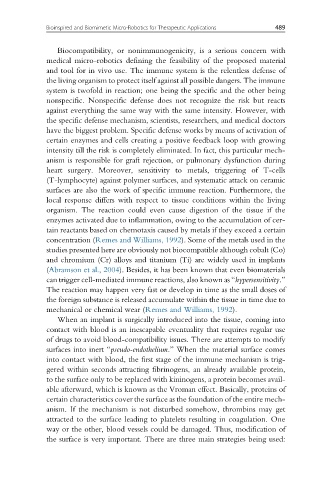Page 495 - Handbook of Biomechatronics
P. 495
Bioinspired and Biomimetic Micro-Robotics for Therapeutic Applications 489
Biocompatibility, or nonimmunogenicity, is a serious concern with
medical micro-robotics defining the feasibility of the proposed material
and tool for in vivo use. The immune system is the relentless defense of
the living organism to protect itself against all possible dangers. The immune
system is twofold in reaction; one being the specific and the other being
nonspecific. Nonspecific defense does not recognize the risk but reacts
against everything the same way with the same intensity. However, with
the specific defense mechanism, scientists, researchers, and medical doctors
have the biggest problem. Specific defense works by means of activation of
certain enzymes and cells creating a positive feedback loop with growing
intensity till the risk is completely eliminated. In fact, this particular mech-
anism is responsible for graft rejection, or pulmonary dysfunction during
heart surgery. Moreover, sensitivity to metals, triggering of T-cells
(T-lymphocyte) against polymer surfaces, and systematic attack on ceramic
surfaces are also the work of specific immune reaction. Furthermore, the
local response differs with respect to tissue conditions within the living
organism. The reaction could even cause digestion of the tissue if the
enzymes activated due to inflammation, owing to the accumulation of cer-
tain reactants based on chemotaxis caused by metals if they exceed a certain
concentration (Remes and Williams, 1992). Some of the metals used in the
studies presented here are obviously not biocompatible although cobalt (Co)
and chromium (Cr) alloys and titanium (Ti) are widely used in implants
(Abramson et al., 2004). Besides, it has been known that even biomaterials
can trigger cell-mediated immune reactions, also known as “hypersensitivity.”
The reaction may happen very fast or develop in time as the small doses of
the foreign substance is released accumulate within the tissue in time due to
mechanical or chemical wear (Remes and Williams, 1992).
When an implant is surgically introduced into the tissue, coming into
contact with blood is an inescapable eventuality that requires regular use
of drugs to avoid blood-compatibility issues. There are attempts to modify
surfaces into inert “pseudo-endothelium.” When the material surface comes
into contact with blood, the first stage of the immune mechanism is trig-
gered within seconds attracting fibrinogens, an already available protein,
to the surface only to be replaced with kininogens, a protein becomes avail-
able afterward, which is known as the Vroman effect. Basically, proteins of
certain characteristics cover the surface as the foundation of the entire mech-
anism. If the mechanism is not disturbed somehow, thrombins may get
attracted to the surface leading to platelets resulting in coagulation. One
way or the other, blood vessels could be damaged. Thus, modification of
the surface is very important. There are three main strategies being used:

